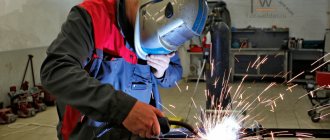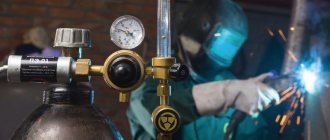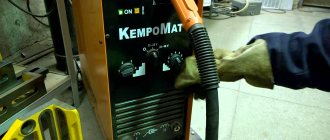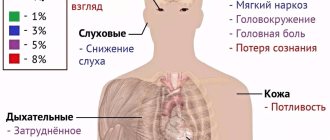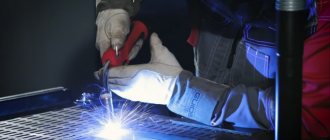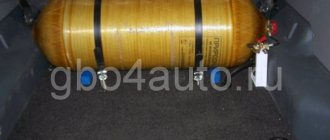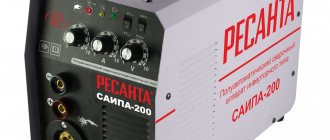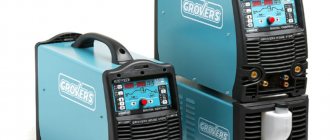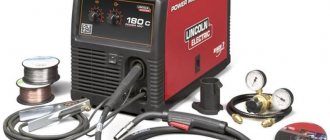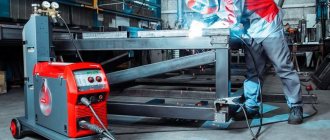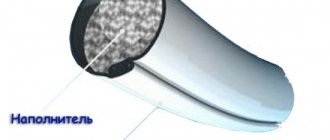04/30/2021 Author: VT-METALL
Issues discussed in the material:
- Operating principle of semi-automatic machine
- Pros and cons of semi-automatic welding
- Equipment for semi-automatic welding
- Semi-automatic welding without gas
- Semi-automatic gas welding
- Which semi-automatic welding method is better?
- Criteria for selecting a welding machine
Which semi-automatic welding is better - with or without gas? It is quite difficult to answer these questions. Each technology has its own advantages and disadvantages, so one or another method is better to use depending on the specific situation.
In general, semi-automatic welding, using any of the methods, is today one of the most popular types of metalworking. But in order to properly take advantage of its benefits, you need to have an idea of the technological nuances of each method.
Features of the method
The flux necessary to create a protective gas environment is included in the welding wire. Burning in an electric arc flame, the powder filler releases the necessary gases, protecting the weld pool from contact with oxygen, nitrogen and water vapor.
The wire is fed by a roller mechanism from a reel at a constant speed through an opening in the torch. The electrical wire also runs through the same hose. The second wire is fixed to the cleaned area of the workpiece.
Flux-containing welding wire for welding without gas is the main feature of the method . Its production is a complex technological process, and it costs several times more than usual. It should also be handled with care - the shell containing the flux powder is fragile and can be damaged if it is moved suddenly or carelessly.
Semi-automatic welding without gas is used in cases where working with gas is inconvenient for one reason or another: on parts of a complex spatial configuration with a large number of through holes, in cramped conditions, etc.
Semi-automatic welding design and operating principle
Semi-automatic welding is an electrical device designed to convert electrical energy into thermal energy using an effect such as an electric arc. The process is carried out using a melting electrode “electrode wire”, which is constantly fed to the welding site.
The electrode is a calibrated copper-plated wire of a given thickness. The coating of the wire is done to ensure good sliding and electrical contact. The wire is placed on top of a special spool, which allows it to unwind and feed evenly during welding.
The welding process is carried out manually, using the following devices: a power source, an electrode supply mechanism, flexible hoses and a gun that the worker uses to apply the weld. Semi-automatic welding machines are divided according to seam protection:
• for submerged arc welding; • for welding work with shielding gases; • for welding work in which flux-cored wire is used.
Most often, semi-automatic machines are used for welding work with shielding gases. This type of welding is used for welding structures made of carbon and alloy steels, or non-ferrous metals.
Carbon dioxide contained in high-pressure cylinders and supplied to the gun is used as a protective gas. Before entering the welding zone, the gas is pre-stabilized using a reducer. Welding in a shielded gas environment has a number of advantages compared to welding using coated electrodes:
Technological advantages of semi-automatic welding
high performance and quality of seams;
semi-automatic welding of short-length seams can be carried out in any spatial position; Connection welding can be carried out in a hanging position, the metal will not flow out.
Production advantages: no harmful emissions during the welding process.
Economic advantages: low cost of welding performed using carbon dioxide compared to the price of welding with electrodes. high indicators of quality and manufacturability.
Semi-automatic welding is an indispensable thing in everyday life. Weld here and there, and if you own a car, then even more so, the equipment periodically needs cosmetic repairs. Making high-quality welds in a semi-automatic machine is a much simpler task than with electrode welding.
If you are going to purchase a semi-automatic welding machine, you need to find out what voltage your electrical network has. If the voltage is lower than the norm, then you should choose a more powerful device, since power indicators depend on the indicators of the electrical network.
If you have access to three-phase voltage (380V), then you should definitely choose a three-phase device. This is due to the fact that the best rectifier current indicators are obtained only when three-phase rectifiers are used, and welding quality indicators depend on this.
Basic operating principle
The basic principle of operation is based on the welding material: flux-containing wire.
When producing such a material, a flux-containing powder is pressed inside an elastic metal shell, its composition reminiscent of the coating of rod electrodes.
The shell serves as a filler material.
The following designs of flux-cored wire used for welding without gas are often found:
- cylindrical shell;
- double-cavity with bend,
- double-cavity with two bends,
- coaxial two-layer
The flux contains rutile, reducing agents and substances for the formation of slag . In addition, alloying additives necessary to give the weld material the required physical and chemical properties are added to the powder: Ni, Mb Mn, Fe and others.
Types of flux-cored wire cross-section profiles.
In this case, it is the shell that is used as a filler material. When flux powder burns in an electric arc flame, carbon dioxide CO2 is released . This cloud displaces air in the area of the weld pool and reliably protects the melt from contact with oxygen and nitrogen from the air, as well as from the water vapor contained in it.
As the burner moves along the seam, the cloud moves along the arc, protecting the bath until the seam material cools and crystallizes.
Semi-automatic welding
A distinctive feature of this type of welding is the use of a movable consumable electrode (wire) and shielding gas.
It is necessary to protect the electric arc so that the molten metal and the environment do not come into contact with each other, because this process (oxidation of nitrogen and oxygen) entails the formation of components such as oxides and nitrites, which, when entering the metal, lead to deterioration in the quality of the weld. It is for these purposes that cylinders with protective gases are used: with argon, helium, carbon dioxide or mixtures thereof.
Principles of semi-automatic welding using wire
Semi-automatic welding is carried out according to the following principle. A moving live wire is passed through a gas nozzle, then it melts as an electric arc acts on it, but a constant arc length is maintained using an automatic feed mechanism. This is the essence of the automation principle, and the choice of welding direction and speed is carried out independently.
You can weld without using gas. To do this, they use self-shielding (“powder-cored”) wire, which contains manganese, silicon and other deoxidizer metals, the combustion of which creates a protective environment around the wire. welding equipment
The welding installation must consist of the following components:
- burner;
- a hose through which wire and gas are supplied;
- wire feeding mechanism;
- control panel;
- coil of wire;
- electrical wire;
- semi-automatic control unit;
- gas supply hose;
- reducer that reduces gas pressure;
- heater;
- high pressure gas cylinder;
- rectifier.
Advantages and disadvantages
The main advantages of using the gasless welding method are as follows:
- mobility increases, since there is no need to drag heavy cylinders, fittings and bulky hoses;
- a wide selection of welding consumable compositions for each combination of welded alloys, their thickness and spatial configuration;
- the ability to weld longer continuous seams compared to the traditional MMA manual welding process with discrete electrodes;
- better conditions for visual control of the arc and seam compared to processes with gas supply; the working area is not covered by a gas nozzle.
This method also has disadvantages:
- a high difference in the price of flux-cored wire increases the cost per linear meter of a seam;
- the need to fine-tune modes;
- the need for a semi-automatic inverter with the option of operating in direct and reverse polarity.
- the thick layer of slag formed increases the complexity of cleaning the seam after welding.
- difficulties when working with thin sheet metal (thinner than 1.5 mm).
Experienced craftsmen who know whether it is possible to cook semi-automatically without carbon dioxide say that increased caution is also necessary when manipulating flux-cored wire: unlike regular wire, it is very fragile and prone to creases.
How to choose a good semi-automatic welding machine
The semi-automatic welding machine got its name due to the mechanism for automatically feeding filler wire and shielding gas. By pressing the torch button, a miniature electric motor is started, as a result of which the unwinder feeds the wire at a constant speed through the metal channel into the welding zone. At the same time, a valve is activated, which supplies argon, carbon dioxide or a mixture of them to the weld pool. The gas and wire feed speed is adjustable.
What can you cook with a semi-automatic machine? The semi-automatic inverter machine allows you to weld thick metals, cast iron, aluminum, stainless steel, and thin sheet materials. The seam practically does not require processing - the formation of slag is minimal. Also, the continuous and uniform supply of electrode wire speeds up the process of joining metals and allows for long continuous seams. For welding fences and non-critical ferrous metal products, it would be more advisable to choose an MMA inverter (for manual arc welding).
Almost all welding inverters allow welding with a conventional fusible electrode or flux-cored wire - its special coating protects the weld pool from interaction with air.
Power. Determines welding performance and the maximum thickness of the welded metal. Indicated in kW. Effective power is always lower than consumed power - part of the electrical energy is converted into thermal energy.
For home use, a device with a power of 3 kW is sufficient. This is enough for welding non-critical structures made of profiles up to 2.5 mm thick, repairing a tank or the bottom of a car. If you work with thicker metals - 4 mm, take a device with a power of 3-5 kW. To melt thick-walled products (about 6-10 mm), you need a device with a power of 6-8 kW or higher.
Welding current. Determines the maximum thickness of the material being welded. If it is not enough, the seam will remain on the surface of the parts being joined and will be easily damaged. With current (approximate data):
- 110-120 A , you can work with wire with a cross-section of 0.6-0.8 mm and weld metal up to 2.5 mm thick;
- 120-160 A – wire diameter is 1 mm, thickness of welded metal is up to 4 mm;
- 160-200 A, parts with a cross-section of up to 4-5 mm are welded using wire with a diameter of 1.2 mm.
Pay attention to the minimum welding current. It is important when working with thin sheet metals and small parts.
Current adjustment. The control knob changes the current strength to adapt the parameters of the electric arc to the characteristics of the parts being processed. Toggle switches come with step-by-step adjustment - each step adds or decreases the indicator by several (50-10 A) or smooth - in steps of 1 ampere or less. For high accuracy and clarity, it is worth purchasing models with a digital indication of current strength.
Voltage. For the private sector, the network voltage indicator is important. With a standard value of about 220 V, it often drops below 200, and even 180 V. When choosing, consider the distance of the house or garage from the transformer from which electricity is supplied to your site. If the network voltage is too low, take a device that can stabilize this indicator. Especially do not trust manufacturers who guarantee excellent performance of inexpensive welding at 160 and even 140 V.
The ease of igniting the arc, especially for beginners, and its elasticity depend on the no-load voltage. The lower the value, the cheaper the device.
Other points. When selecting a good semi-automatic machine, look at the on-duration parameter (DS). For household appliances it rarely exceeds 30-40% in MIG/MAG mode, and this is normal. This means that after 3-4 minutes of operation at peak current, the device needs to cool down for 7 or 6 minutes, respectively. For a house and garage this is enough, but for a production unit the PV should be from 60%. For MMA mode the figure may be higher.
It is advisable to buy a semi-automatic machine with a closed push wire feed mechanism, rather than a pulling one, and protection against short circuits.
Which semi-automatic welding machine to choose
For a farmstead, garage and cottage, a device with a power of about 3 kW with a maximum welding current of 120-160 A is enough. Select the minimum value based on the thickness of the metal being welded. PV is 30-40%. It is important to work during voltage drops up to 200-190 V.
Equipment used
Any semi-automatic MIG/MAG machine with the ability to switch from direct to reverse polarity is suitable for welding without gas. The normal mode when working with gas supply is reverse polarity. The plus is connected to the workpiece, and the minus to the burner. To work with flux-cored wire, the correct mode is straight polarity, as when welding with electrodes . This increases the energy of the arc and the temperature it develops.
The feed mechanism of a wire welding machine operating without gas must be perfectly adjusted to avoid distortions and creases. What is suitable for regular wire will destroy flux wire.
Device characteristics
In order to choose the right semi-automatic welding machine for working without carbon dioxide, the following nuances should be taken into account:
- the device must be light and small-sized so that there is no need for a gas cylinder;
- the device must be affordable;
- the inverter device must have ample opportunities to configure the parameters of the electric arc;
- the unit must allow the use of different types of welding materials.
When choosing a welding technology, it is also necessary to take into account the fact that carbon dioxide is heavier than air and sinks downward. Therefore, the method is unsuitable for working in the upper position and with large slopes of inclined seams : the weld pool will not be sufficiently protected. Only the most qualified and experienced welders will be able to weld ceiling seams using flux-cored wire; it is too difficult for beginners.
Semi-automatic welding machine without gas
One of the most frequently asked questions about welding is “how does a semi-automatic welding machine without gas differ from a unit running on gas?” There are many different arguments and thoughts on this topic, but what is the main difference? Well, let's try to figure this out.
Generally speaking, using carbon dioxide (or semi-automatic gas welding machines) welding is carried out protected by an inert gas environment: here either ordinary carbon dioxide or a mixture of carbon dioxide and argon can be used. Since carbon dioxide blocks a process such as combustion, therefore, there are no high temperatures at the welding site, the metal does not burn through.
The semi-automatic welding machine, which does not use gas, uses a special wire coated with flux. During the welding process, the flux burns, releasing the same carbon dioxide, which also prevents the metal from burning.
Pros and cons of welding with and without gas
When welding without gas, the welding zone is completely protected. Flux creates a protective surface because flux is lighter than metal.
When welding with gas (for example, carbon dioxide), the welding conditions are the most favorable; in addition, the metal is cooled in the welding zone. This method is used a little more often. In addition, it is more profitable from an economic point of view.
However, quite a few people use the second welding option, mostly due to the fact that when using a welding machine without gas, the seam comes out more neat. Carefully!
When welding with a welding machine without gas, under no circumstances should you use ordinary wire. When using ordinary wire, the quality of the seam will be very low, it will turn out uneven, and will have holes. There will be a serious increase in wire consumption, since a significant amount of it will simply evaporate.
And most importantly, in the welding area (in the weld pool) the influence of oxygen will be observed, and therefore, oxides and many cavities will form in the weld. Which welding method you choose, with or without gas, is entirely your decision. And you can always easily pick up the equipment necessary for this in specialized stores.
Settings
The quality of the seam directly depends on the correct settings of the machine parameters. Before starting welding you need:
- determine the strength of the welding current based on the material of the workpiece, the thickness of the wire, the thickness of the parts;
- adjust the speed of the feed mechanism by installing one of the sets of gears;
- check the operation of the arc on a test section;
- if the arc is stable and the quality of the seam is good, you can weld the main seam.
If the current is too high or too low, you should adjust the settings before starting production welding.
Welding technique
The technique has much in common both with the work of the MMA method with discrete electrodes, and with the work of a gas semi-automatic MIG/MAG .
Before starting welding, you should clean the seam area using an angle grinder to clean the workpiece from mechanical impurities, traces of rust, and remnants of old paint coatings. Next, it is necessary to thoroughly degrease the seam area and the adjacent area no less than 10 cm in order to wash off all oil and fat contaminants.
The seam edges are cut without any special features.
The burner must be moved along the seam smoothly, without jerking. The electrode should be pulled off and the arc extinguished at the end of the seam smoothly so as not to disperse the protective cloud of carbon dioxide on the cooling weld pool.
Welders who know how to weld parts with flux-cored wire without gas pay attention to the following nuance. During welding, there is still a risk that slag from the burning flux powder will unexpectedly flow into the weld pool . In this case, both the strength and durability of the seam in this area may suffer.
In this case, you should interrupt the work, clean the seam area from slag and re-weld it.
Working with an inverter
To work with flux-cored wire, you will need a semi-automatic inverter welding machine with the ability to switch direct and reverse polarity modes - the answer to the question: “what is the name of the type of apparatus for such work?” The “minus” contact is connected to the burner, and the “plus” contact is connected to a cleaned and degreased area on the workpiece.
When welding without gas, straight polarity is used
If a feed mechanism with soft rollers or reduced clamping force is available, it is better to use it. It significantly reduces the risk of damage and wire breaking during feeding.
Important! During welding, you should also avoid sharp turns of the hand with the torch, bends, and especially kinks of the welding hose - this can also damage the fragile wire.
Is it possible to cook without gas using a semi-automatic machine? Semi-automatic welding without gas is widely used where it is necessary to increase the mobility of the welder and it is inconvenient to carry a bulky apparatus with gas cylinders. A wide range of flux-containing welding wire, which forms a protective cloud of carbon dioxide in the electric arc flame, allows you to successfully weld parts of different configurations from various alloys.
The best semi-automatic welding machines MIG/MAG, MMA
Devices for welding in a protective gas environment and in manual mode with consumable electrodes.
1
Aurora OVERMAN 205 (MIG/MAG, MMA)
Rating:5.0
- welding inverter
- manual arc welding MMA
- semi-automatic welding (MIG/MAG)
- Max. welding current: 180 A (MMA), 200 A (MIG/MAG)
- power: 8 kVA
Average price: RUB 36,100
Lightweight semi-automatic welding machine with the ability to weld with stick electrodes. Works with cored self-shielding wire. With a current of up to 200 A and a power of up to 8 kW, it will become a reliable assistant in a garage or production workshop with significant volumes of work. It has proven itself to be excellent when welding aluminum - suitable for auto repair shops and service stations. Long turn-on times are ensured by an updated cooling system based on four radiators. For operation at low temperatures, a socket is provided for connecting the gearbox heating. The device is susceptible to voltage drops of up to 160-140 V.
Peculiarities:
- current and voltage regulator;
- inductance control;
- gearbox heating option;
- changing polarity on the body.
2
Svarog REAL MIG 200 (N24002N) (MIG/MAG, MMA)
Rating:4.9
- welding inverter
- manual arc welding MMA
- semi-automatic welding (MIG/MAG)
- Max. welding current: 160 A (MMA), 200 A (MIG/MAG)
- power: 7.70 kVA
Average price: RUB 32,580
An advanced unit for use in everyday life and at work. The burner is equipped with a hook that clings to almost anything. The front panel contains regulators: voltage in MIG mode, wire feed speed, inductance (arc force). The last option stabilizes the arc and eliminates sagging when welding thin metals. For the MMA mode there is a current regulator within the range of 10-160 A. Under the housing cover there is a table with recommended welding modes: the correspondence of current, metal thickness and wire/electrode. Peculiarities:
- aluminum welding;
- working with flux-cored wire;
- afterburning of wire;
- many regulators;
- idle run of welding wire.
3
RESANTA SAIPA-220 (MIG/MAG)
Rating:4.8
- welding inverter
- semi-automatic welding (MIG/MAG)
- Max. welding current: 220 A (MIG/MAG)
